Best plants for conservatories (by type and need)
Sun-loving tropical plants
A heated conservatory (where temperatures won’t drop below 15 degrees) is a great place to grow tropical plants. With lush foliage and vibrant colours, tropical plants thrive in warm, bright and humid environments.
Bird of paradise (Strelitzia)
These handsome plants are named after their flowers, which, with beak-like spathes and upright orange and blue petals, bear a strong resemblance to the head of a tropical bird.
It may take a few years, but Strelitzia will eventually bloom between winter and spring. Throughout the rest of the year, they have glossy, paddle-shaped leaves which grow on long, slender stems. They can grow up to 2.5 metres tall.
Strelitzias, which are native to South Africa, flourish in warm, bright and humid environments, and are a popular choice for a conservatory. They need space to grow and temperatures above 10 degrees. During spring and summer, the plant should be watered regularly and fed a liquid fertiliser. In autumn and winter, water more sparingly.
To maximise humidity, stand Strelitzia on a tray of damp gravel and mist the leaves frequently.
Bougainvillea
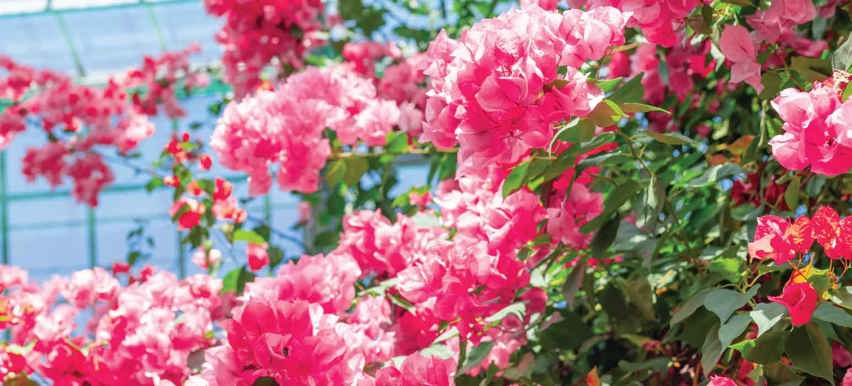
“These large, tropical climbers make striking additions to a conservatory,” says Domoney. “Their brightly coloured, flower-like bracts conjure some of that Mediterranean warmth.”
Bougainvillea need lots of sunlight and warm temperatures. Water them frequently (up to three times a week) in the spring and summer and more occasionally in the autumn and winter, allowing the soil to almost dry out.
Bougainvillea usually flower in the summer and autumn. To encourage growth, feed the plant a nitrogen-rich liquid fertiliser weekly from mid-spring onwards, switching to a high potassium feed once the bracts have started to develop. Once the bracts have faded, remove the dead growth and cut back any long shoots to encourage new blooms.
Hibiscus (Hibiscus rosa-sinensis)
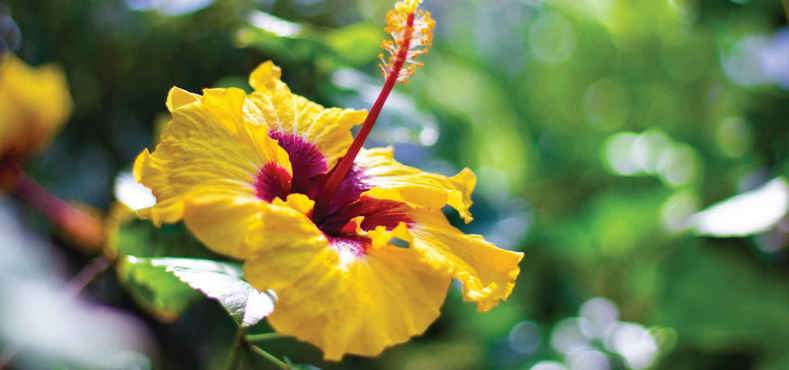
Tropical hibiscuses have large, triumphant flowers with vibrant, and sometimes patterned, petals which open, trumpet-like, around a central stamen. They come in a rainbow of colours, from deep fuchsias to buttery yellows. Their showy blooms may be short-lived, but the plant will produce new flowers for months on end.
Native to China, tropical hibiscus is well-suited to a warm, sunny conservatory. It likes high humidity, so mist it, place it on a gravel tray, or group it together with other moisture-loving plants. During the growing season, water the plant more frequently and feed every one to two weeks with a liquid fertiliser.
Orchids
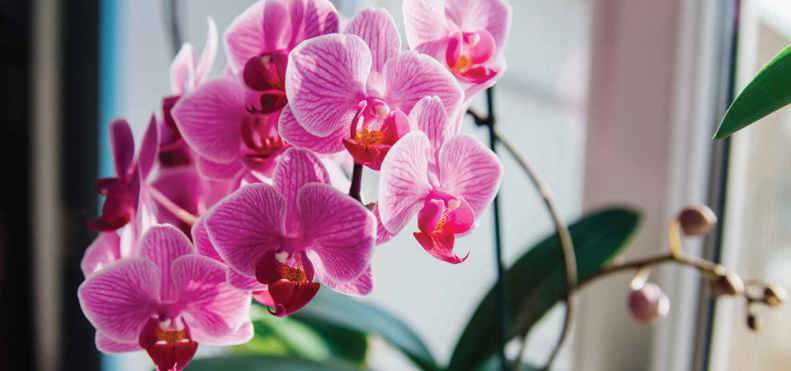
If you have a north or east-facing conservatory, it might be a good spot for orchids. Generally, these plants like bright, indirect sunlight, but will be damaged if the light is too intense.
Phalaenopsis, or moth orchids, are one of the most popular varieties. They have strong, leathery leaves with delicate blooms that come in a vast range of colours and patterns. They can flower throughout the year, and are one of the longest blooming orchid varieties.
“Moth orchids are easy to take care of, but don’t be afraid to try other orchids too,” says Domoney. “Cymbidiums, or boat orchids, have exotic, beautifully patterned flowers. Zygopetalums have flecked petals and a contrasting ‘lip’. They’re known for their amazing fragrance, which is slightly peppery.”
Most orchids need regular watering, ideally with boiled water or rainwater, and a humid environment. Stand them on a gravel tray and mist the leaves frequently, but avoid spraying the flowers.
Cymbidiums prefer cooler temperatures than other orchids, and can benefit from being moved outside in the summer to help encourage flower growth.
Drought-tolerant options (low maintenance)
Cacti and succulents are great, low maintenance additions to sunny conservatories that get hot in the summer. Conveniently, these resilient desert plants are also able to withstand cooler nighttime and winter temperatures, so are a good choice for unheated conservatories.
Succulents
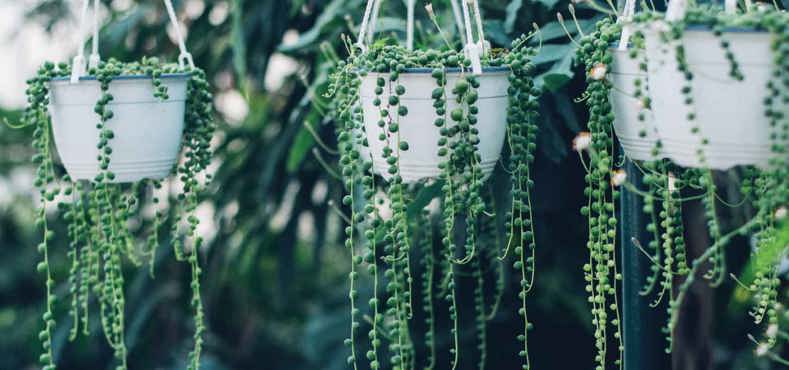
Succulents store water in their stems, roots or thick, fleshy leaves, which allows them to thrive with little watering. Most prefer drier environments, but others can handle higher humidity.
Whether you prefer plump or spiky leaves; tightly curled rosettes or taller centrepieces, there is a succulent to please everyone. Some Aeonium varieties, like the Aeonium ‘Zwartkop’, have a higher tolerance for humidity. The Zwartkop grows dark, purplish rosettes of leaves on branches, and can yield large, cone-shaped clusters of tiny yellow flowers in spring.
Echeveria succulents also grow in small rosettes, producing flowers in the spring and summer. Echeveria ‘Blue Frills’ (or curls) is named after its frilly-edged leaves, which have a pink tint. In the spring, it can grow bright orange or pinkish flowers.
Curio rowleyanus, known as string of pearls for its round, pea-like leaves, is a quirky trailing succulent which will tumble over the sides of a shelf or basket.
Cacti
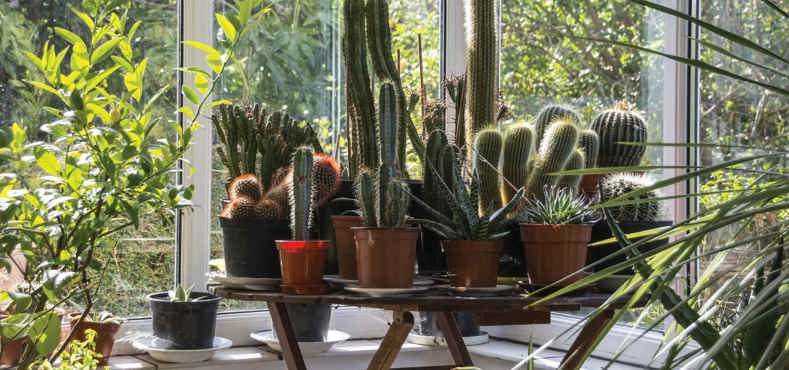
Like succulents, cacti are drought-tolerant, preferring dry, sunny conditions.
“Opuntia microdasys is a delight for a conservatory. It’s got distinctive round pads that look like rabbit’s ears, hence its nickname: ‘Bunny ears’,” says Domoney. “The golden barrel (Echinocactus grusonii), with tough, blonde spikes can grow to up to a metre across, while mature plants may yield cheerful yellow flowers.”
Candelabra trees (Euphorbia ingens), which grow in fleshy green columns and can produce unusual clusters of yellow flowers on its tips, are also a good choice for a conservatory. Alternatively, the blue torch cactus (Pilosocereus pachycladus) grows upright in tall blue-green columns which are ribbed with little yellow spikes.
Jade plant (Crassula ovata)
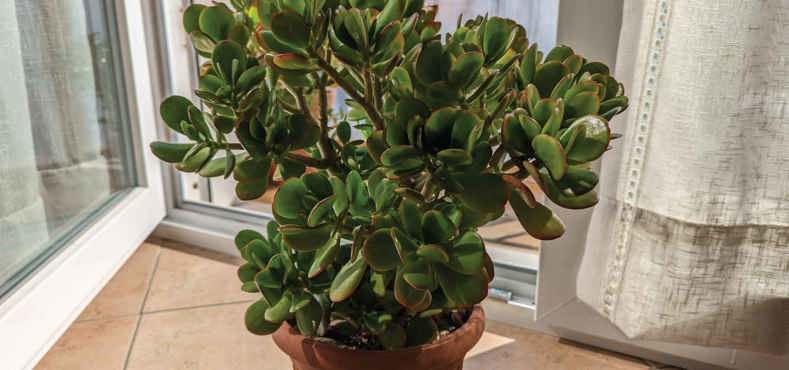
Native to southern Africa, the jade plant grows like a miniature tree, with woody stems and thick, oval-shaped leaves. There are several varieties, offering leaves in different colours and shapes.
“Jade plants are often known as ‘friendship plants’ or ‘money plants’, because they are said to bring friendship and good fortune,” says Domoney. “They are sometimes given as housewarming gifts, because they are believed to bring positive energy into the home in Feng Shui. Plus, they can live for up to 100 years.”
Jade plants are excellent for beginners because they are easy to look after, requiring bright light and well-drained compost. They should be watered sparingly in winter and lightly in spring and summer to keep the soil moist, although they can cope with drought. A liquid fertiliser in spring and summer will help with healthy growth.
Plants that help reduce condensation
Plants’ leaves and roots absorb water from their soil and the air, but they also release moisture in a process called transpiration. Some plants, like succulents and cacti, store water in their leaves and do not release as much into the air, which means that they can help to reduce condensation.
NASA’s Clean Air Study found that other plants are particularly effective at absorbing pollutants and water from the air.
Peace lily (Spathiphyllum)
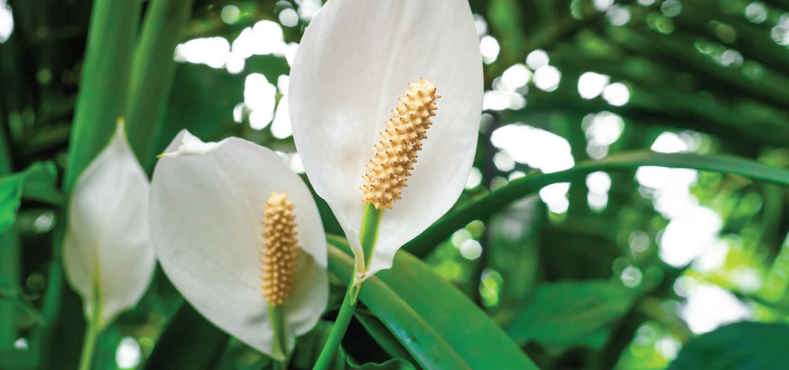
Peace lilies are one of the most effective plants at removing moisture from the air. They are popular houseplants, growing dark green leaves and petal-like white spathes. In their centre is a knobbly white spike called a spadix which turns green as the plants get older.
Peace lilies like bright, indirect light and a warm spot, so are a good pick for a north-facing, heated conservatory. They need humidity, so place them on a gravel tray and mist them regularly.
Water peace lilies more regularly during the growing season, ideally with rainwater or filtered water, and avoid overwatering, especially in the winter.
Boston fern (Nephrolepis exaltata)
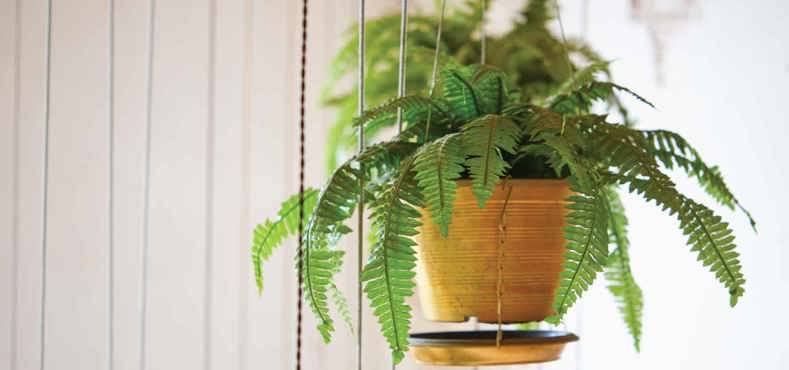
Discovered in a shipment sent from Philadelphia to Boston in the 19th century, the Boston fern has pretty green fronds which grow up and outwards, and look wonderful hanging over the sides of a planter.
Originally from the humid forests of South America and the West Indies, Boston ferns love a warm, tropical environment. They should be planted in a bright room, out of direct sunlight, and kept at a steady temperature. Mist them regularly to keep their humidity levels up. Keep the soil moist during the spring and summer, but allow the compost to try out between watering later in the year.
In return, Boston ferns will help to remove condensation from your home and purify the air.
Spider plant (Chlorophytum comosum)
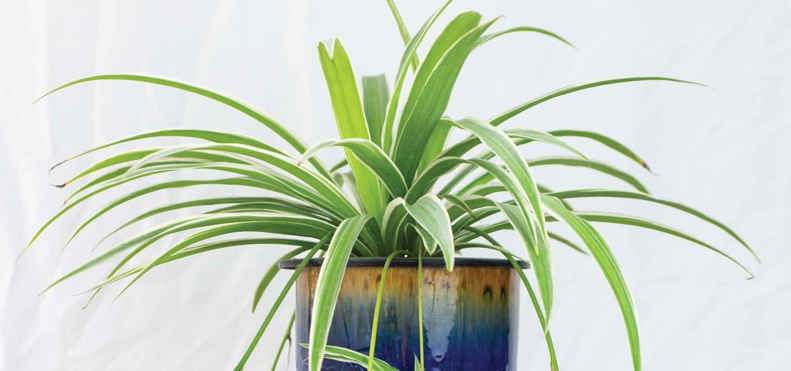
“Spider plants are popular for good reason. They are long-living, easy-to-care-for, and their long, arching stems have a wonderful impact,” says Domoney.
Most spider plants have long, slender leaves with a stripe down the centre. Mature plants will produce small white flowers and little plantlets on their stems, making them very easy to propagate.
Spider plants do best in bright, indirect light, which they need to keep their leaves a healthy colour. Avoid placing them near a radiator, which will dry out the air, and mist them occasionally if you notice the leaves browning. Water spider plants regularly but sparingly: the soil should be slightly moist to the touch, but not waterlogged.
Areca palm (Chrysalidocarpus lutescens)
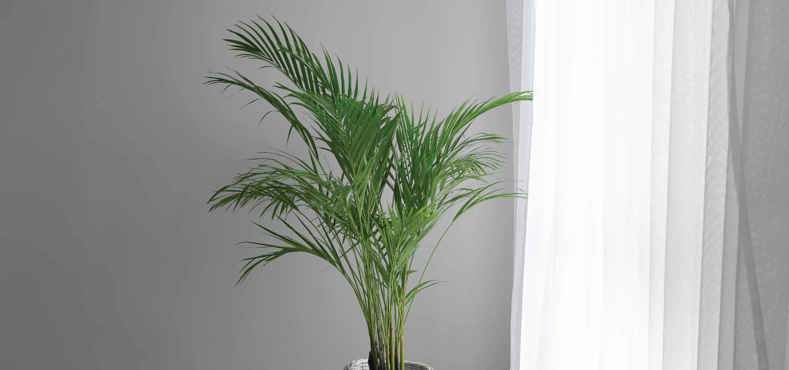
Native to Madagascar, the areca palm is known for its lush feather-shaped fronds, which grow from elegant stems. Outdoors, the plant can grow to around 10 metres tall, although in the home, they’re more likely to reach a more manageable 2 metres. The plant is sometimes called a bamboo or butterfly palm, and there are many different varieties available.
For the areca palm to thrive, it needs conditions similar to its native environment: bright, indirect light, warmth and humidity. Keep it out of direct sunlight and water with rainwater or bottled water so that the soil is moist but not waterlogged. This will be more frequent in the summer, and much less in the winter. To keep humidity levels up, mist the plant regularly and stand it on a pebble tray. During the growing season, feed it with a balanced fertiliser.
Shade-loving plants for north-facing conservatories
If you’ve got a conservatory which isn’t flooded with light year-round, these plants thrive in north-facing spaces.
Ferns
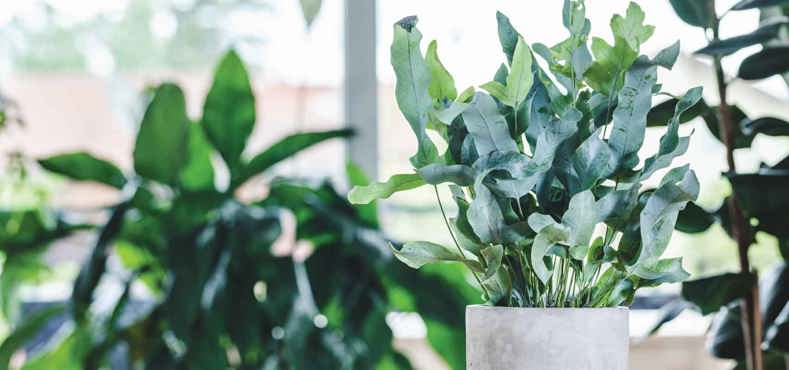
Victorians popularised the conservatory as a space to grow plants and above all, they loved ferns.
These lush foliage plants remain well-loved and come in thousands of different varieties, so you’re bound to find one that suits your growing conditions. For north-facing conservatories, look for shade-loving species like the maidenhair fern (Adiantum raddianum), which is known for its fan-shaped leaves on dark stems, or the evergreen ‘Blue Star’ (Phlebodium aureum) with wider, wiggly blue-green fronds.
The asparagus fern (Asparagus setaceus) has delicate, fluffy-looking foliage and can produce small, white flowers, while the bird’s nest fern (Asplenium nidus) has thicker, lance-shaped fronds which grow upright and have wavy edges.
Grow these plants in bright, indirect light, and keep the soil consistently moist without it being soggy. They like high humidity, so benefit from a gravel tray and regular misting.
Calathea
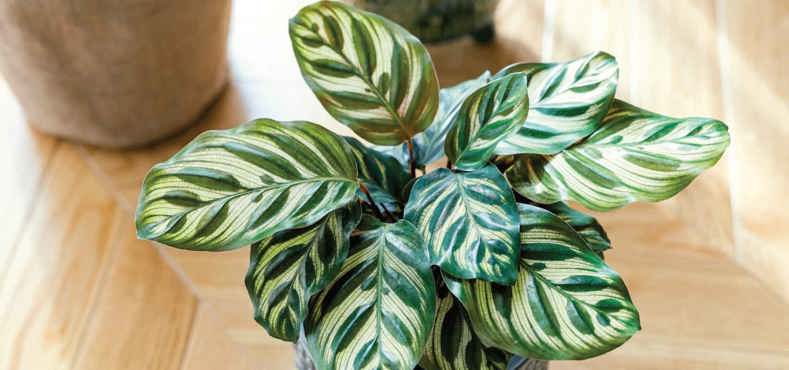
“Calatheas are some of the most dramatic foliage plants,” says Domoney. “The peacock plant (Calathea makoyana) has remarkable, intricately marked leaves, for example, while the rattlesnake plant (Calathea lancifolia) has long, wiggly leaves with a striped green pattern on top and a striking burgundy underside.”
Calathea are often said to symbolise new beginnings. They’re also known as prayer plants, because their leaves move upwards and fold together at night, as if in prayer.
Calathea plants come in different patterns and colours. Generally, they should be kept in bright rooms, out of direct sunlight, and placed in a spot where the temperature is unlikely to fluctuate too much.
They like moist air, and prefer to be watered with rainwater or tap water that has been left to stand. Keep the soil moist during the spring and summer, but allow it to dry a little more in the winter.
Devil’s Ivy (Epipremnum)
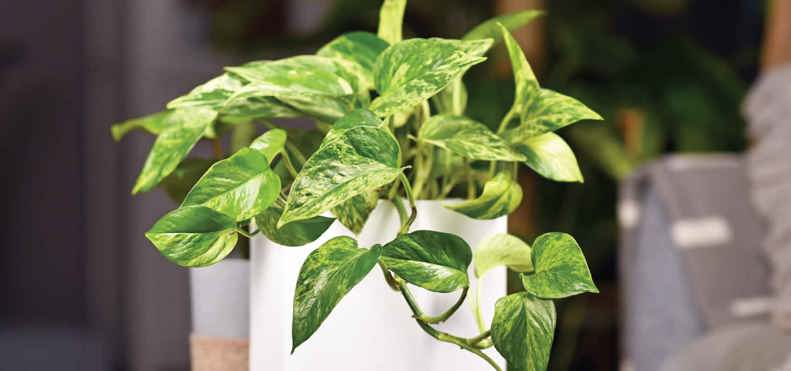
Pothos is thought to have earned its ‘devil’s ivy’ nickname because it is so difficult to kill. Prized for its green, heart-shaped leaves that are flecked with yellow, it can be trained to climb, or looks great cascading over the sides of a pot or hanging basket.
Pothos is a wonderful plant for beginners as it is easy to grow. It needs a bright spot out of direct sunlight, and prefers higher levels of humidity. It should only be watered once the top layer of soil starts to feel dry, and benefits from feeding every few weeks in the spring and summer.























